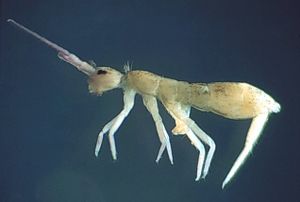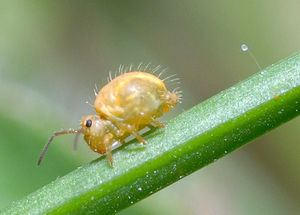Springtail
Description
Springtails are members of the Collembola family and are relatively small (typically less than 6 millimeters in length), with as many as six abdominal segments [1]. They have a tubular appendage called a collophore, which protrudes from the first abdominal segment. The collophore used to be thought to be a stabilizing mechanism for the collembola when it jumped by sticking to the surface on which it landed. More recent research has concluded that the collophore is used in osmoregulation, water intake, and excretion [2].

Collembola that live in the upper soil layers are often referred to as Springtails because of a tail-like appendage found among most species, called the furcula. It is a forked appendage attached to the fourth segment by a structure called the retinaculum and is used for jumping when the animal is threatened; it is not used for normal locomotion [3]. In as little as 18 milliseconds the furcula can be released from the retinaculum, snapping against the substrate and flinging the springtail into the air [4]. A reason that this mechanism is not used in typical locomotion is that it’s direction is very unpredictable. When the furcula is released, the springtail is sent tumbling through the air on an arbitrary trajectory, landing randomly [3].
Springtails are able to reduce their body size by up to 30% through genetically controlled molting if temperatures are high enough. Warmer conditions increase energy needs, as well as metabolic rates, therefore a smaller body size comes with many advantages to the organism [5].
Habitat & Distribution
Springtails are typically found in leaf litter and other decaying organic material [6]. They mainly consume fungal hyphae and spores, but can also consume bacteria, plant material and pollen, minerals, and animal remains [7].
They are one of the most abundant macroscopic animals in the world, with estimates of 100,000 individuals per square meter of ground where soil and mosses occur [8]. The only other amimals with global populations of a similar size are thought to be nematodes, crustaceans, and mites. Most springtails are difficult to see with the naked eye with few exceptions, including the snow flea [9]. Several species of springtail climb trees, and form a dominant component of canopy faunas. These species are typically smaller than soil populations of the same species by 1-2 orders of magnitude [10].

Overall, springtails are very susceptible to desiccation due to the structure of their respiratory system, although sensitivity to drought varies from species to species [11].
The distribution of springtail species is affected by environmental factors such as soil acidity, moisture, and light. Altitudinal changes in species distribution can be at least partially explained by increased acidity at higher elevation, and moisture requirements explain why some species cannot live above ground, or retreat into the soil during dry seasons [12] [13].
Evolution
Springtails have been found as far back as the Early Devonian in the fossil record. The fossil of Rhyniella praecursor, the oldest terrestrial arthropod, was found in the Rhynie chert of Scotland and is over 400 million years old [14]. Fossil collembola are very rare, and most are preserved in amber. Even these are rare, and all but one of the fossils from the Cretaceous belongs to extinct genera [15].
In total, there are around 3,600 different species of springtail [16].
Environmental Impacts
References
1. Davies, W. Maldwyn (1927). "On the tracheal system of Collembola, with special reference to that of Sminthurus viridis, Lubb" (PDF). Quarterly Journal of Microscopical Science. 71 (281): 15–30.
2. Eisenbeis, G., 1982. Physiological absorption of liquid water by Collembola: absorption by the ventral tube at different salinities. Journal of Insect Physiology 28:11–20.
3. Christian, E., 1978. The jump of the springtails. Naturwissenschaften 65:495-496.
4. Piper, Ross (2007). Extraordinary animals: an encyclopedia of curious and unusual animals. Santa Barbara, California: Greenwood Press.
5. "The incredible shrinking springtail". Science. 341 (6149): 945. 30 August 2013. doi:10.1126/science.341.6149.945-a.
6. Hopkin, Stephen P. (1997). "The biology of the Collembola (springtails): the most abundant insects in the world" (PDF). Natural History Museum.
7. Chen, Benrong; Snider, Richard J. & Snider, Renate M. (1996). "Food consumption by Collembola from northern Michigan deciduous forest" (PDF). Pedobiologia. 40 (2): 149–161.
8. Ponge, Jean-François; Arpin, Pierre; Sondag, Francis & Delecour, Ferdinand (1997). "Soil fauna and site assessment in beech stands of the Belgian Ardennes" (PDF). Canadian Journal of Forest Research. 27 (12): 2053–2064. doi:10.1139/cjfr-27-12-2053.
9. Island Creek Elementary School. "Snow Flea. Hypogastrura nivicola". Study of Northern Virginia Ecology. Fairfax County Public Schools.
10. Shaw, Peter; Ozanne, Claire; Speight, Martin & Palmer, Imogen (2007). "Edge effects and arboreal Collembola in coniferous plantations" (PDF). Pedobiologia. 51 (4): 287–293. doi:10.1016/j.pedobi.2007.04.010.
11. Nickerl, Julia; Helbig, Ralf; Schulz, Hans-Jürgen; Werner, Carsten & Neinhuis, Christoph (2013). "Diversity and potential correlations to the function of Collembola cuticle structures" (PDF). Zoomorphology. 132 (2): 183–195. doi:10.1007/s00435-012-0181-0.
12.Loranger, Gladys; Bandyopadhyaya, Ipsa; Razaka, Barbara & Ponge, Jean-François (2001). "Does soil acidity explain altitudinal sequences in collembolan communities?" (PDF). Soil Biology and Biochemistry. 33 (3): 381–393. doi:10.1016/S0038-0717(00)00153-X.
13. Detsis, Vassilis (2000). "Vertical distribution of Collembola in deciduous forests under Mediterranean climatic conditions" (PDF). Belgian Journal of Zoology. 130 (Supplement 1): 57–61.
14. Daly, Howell V.; Doyen, John T. & Purcell, Alexander H. (1998). Introduction to insect biology and diversity (2nd ed.). New York: Oxford University Press. ISBN 0-19-510033-6.
15. Mari Mutt, José A. (1983). "Collembola in amber from the Dominican Republic" (PDF). Proceedings of the Entomological Society of Washington. 85 (3): 575–587.